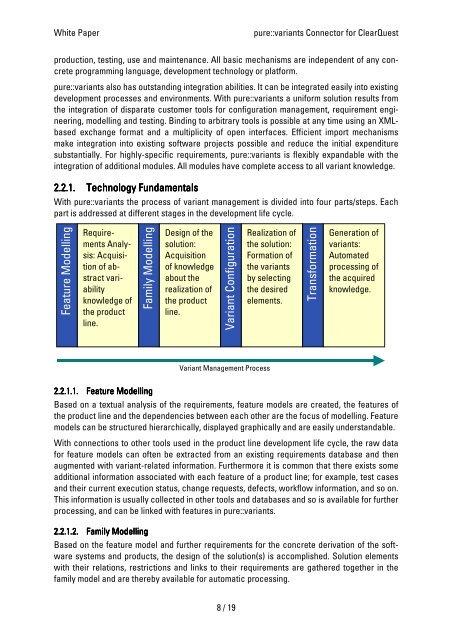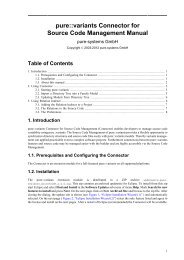White Paper - pure-systems GmbH
White Paper - pure-systems GmbH
White Paper - pure-systems GmbH
You also want an ePaper? Increase the reach of your titles
YUMPU automatically turns print PDFs into web optimized ePapers that Google loves.
<strong>White</strong> <strong>Paper</strong> <strong>pure</strong>::variants Connector for ClearQuest<br />
production, testing, use and maintenance. All basic mechanisms are independent of any concrete<br />
programming language, development technology or platform.<br />
<strong>pure</strong>::variants also has outstanding integration abilities. It can be integrated easily into existing<br />
development processes and environments. With <strong>pure</strong>::variants a uniform solution results from<br />
the integration of disparate customer tools for configuration management, requirement engineering,<br />
modelling and testing. Binding to arbitrary tools is possible at any time using an XMLbased<br />
exchange format and a multiplicity of open interfaces. Efficient import mechanisms<br />
make integration into existing software projects possible and reduce the initial expenditure<br />
substantially. For highly-specific requirements, <strong>pure</strong>::variants is flexibly expandable with the<br />
integration of additional modules. All modules have complete access to all variant knowledge.<br />
2.2.1. 2.2.1. 2.2.1. Technology Technology Fundamentals<br />
Fundamentals<br />
With <strong>pure</strong>::variants the process of variant management is divided into four parts/steps. Each<br />
part is addressed at different stages in the development life cycle.<br />
Feature Modelling<br />
RequirementsAnalysis:Acquisition<br />
of abstractvariability<br />
knowledge of<br />
the product<br />
line.<br />
Family Modelling<br />
2.2.1.1. 2.2.1.1. 2.2.1.1. Feature Feature Feature Modelling<br />
Modelling<br />
Based on a textual analysis of the requirements, feature models are created, the features of<br />
the product line and the dependencies between each other are the focus of modelling. Feature<br />
models can be structured hierarchically, displayed graphically and are easily understandable.<br />
With connections to other tools used in the product line development life cycle, the raw data<br />
for feature models can often be extracted from an existing requirements database and then<br />
augmented with variant-related information. Furthermore it is common that there exists some<br />
additional information associated with each feature of a product line; for example, test cases<br />
and their current execution status, change requests, defects, workflow information, and so on.<br />
This information is usually collected in other tools and databases and so is available for further<br />
processing, and can be linked with features in <strong>pure</strong>::variants.<br />
2.2.1.2. 2.2.1.2. Family Family Modelling<br />
Modelling<br />
Design of the<br />
solution:<br />
Acquisition<br />
of knowledge<br />
about the<br />
realization of<br />
the product<br />
line.<br />
Variant Configuration<br />
Variant Management Process<br />
Based on the feature model and further requirements for the concrete derivation of the software<br />
<strong>systems</strong> and products, the design of the solution(s) is accomplished. Solution elements<br />
with their relations, restrictions and links to their requirements are gathered together in the<br />
family model and are thereby available for automatic processing.<br />
8 / 19<br />
Realization of<br />
the solution:<br />
Formation of<br />
the variants<br />
by selecting<br />
the desired<br />
elements.<br />
Transformation<br />
Generation of<br />
variants:<br />
Automated<br />
processing of<br />
the acquired<br />
knowledge.




